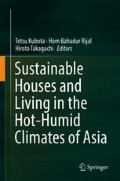Abstract
This chapter discusses the villages and houses of the Lue ethnic group, which is one of the ethnic minority groups in the peripheral area of Luang Prabang, Laos. Lue originally lived in Sip Song Pan Na, a former kingdom of Dai in Yunnan province of current China. Today, Lue are spread throughout Yunnan, Shan State of Northern Myanmar, and Northern Thailand. They are organized into nuclear families and are dedicated practitioners of Theravada Buddhism. This chapter describes the remarkable characteristics of their village and houses, from architectural and ethnographic perspectives. The spatial structure of the village will be described. This chapter also examines the physical structure, construction process, and spatial organization of Lue houses.
Access this chapter
Tax calculation will be finalised at checkout
Purchases are for personal use only
Notes
- 1.
Field surveys were conducted in 2012, 2013, 2015, and 2016, for a total of 40 days. We got the measurement of 40 houses and conducted 42 interviews with villagers, together with the measurement of each house site and the whole village. After the measurement of the house, we drew plan (1/50), site plan (1/200), and whole village map (1/500).
- 2.
The town is well known for its numerous Buddhist temples. Every morning, hundreds of monks from the various monasteries walk through the streets collecting alms.
- 3.
Selection criteria for the cultural village is as follows: good health management, village security, does not use slash-and-burn agriculture and deforestation, good reservation of the water source, and observes the traditional customs of the village.
- 4.
Although there was slash-and-burn agriculture in the village in the early 1970s, villagers discovered that rice crops are sufficient without the slash-and-burn. Slash-and-burn has not been carried out at all since then.
- 5.
1 US dollar is nearly equal to 8300 kiip in 2017.
- 6.
It has also been used on the outer wall and posts of village temple.
- 7.
Entering into the sleeping room without permission from the house owner or members of the house is strongly prohibited in the village.
References
Ikuro S (2014) Spatial characteristics seen among the Phuan in Vientiane province, Lao P.D.R., especially focusing on the house and village. J Fine Arts 2557(1):21–66 (CMU)
Izikowitz KG, Sorensen P (eds) (1982) The house in East and Southeast Asia: anthropological and architectural aspects. Curzon Press, London
Charpentier S (1982) The Lao house: Vientiane and Louang Prabang. In: Izikowitz KG, Sorensen P (eds) The house in East and Southeast Asia: anthropological and architectural aspects. Curzon Press, London
Clément S (1982) The spatial formation of the Lao house. In: Izikowitz KG, Sorensen P (eds) The house in east and Southeast Asia: anthropological and architectural aspects. Curzon Press, London
Clément S (1982) The Lao house among the Thai houses: a comparative survey and a preliminary classification. In: Izikowitz KG, Sorensen P (eds) The house in east and Southeast Asia: anthropological and architectural aspects. Curzon Press, London
Ikuro S (2009) Houses. In: Akimichi T (ed) An illustrated eco-history of the Mekong River Basin. White Lotus, Bangkok, pp 74–77
Ikuro S et al (2015) A study on religious space in and around the house: Ethnographic-Architectural Study of the House of Mainland South-East Asian Society, Part 2. In: Summaries of technical papers of annual meeting. Architectural Institute of Japan, pp 1207–1208 (in Japanese)
Ikuro S et al (2015) Symbolic analysis of the ritual process at the house among Lue in Lao P.D.R.: Ethnographic-Architectural Study of the House of Mainland South-East Asian Society, Part 1. In: Summaries of technical papers of annual meeting 2015. Architectural Institute of Japan, pp 1205–1206 (in Japanese)
Ikuro S (2013) Characteristics of the house of Lue in Northern part of Lao P.D.R.: integrated study of man-lived-space at the wetland area of mainland South-East Asia, part 3. In: Summaries of technical papers of annual meeting 2013. Architectural Institute of Japan, pp 1307–1308 (in Japanese)
Author information
Authors and Affiliations
Corresponding author
Editor information
Editors and Affiliations
Rights and permissions
Copyright information
© 2018 Springer Nature Singapore Pte Ltd.
About this chapter
Cite this chapter
Shimizu, I. (2018). Laos: Indigenous Houses of a Lue Village in Luang Prabang. In: Kubota, T., Rijal, H., Takaguchi, H. (eds) Sustainable Houses and Living in the Hot-Humid Climates of Asia. Springer, Singapore. https://doi.org/10.1007/978-981-10-8465-2_9
Download citation
DOI: https://doi.org/10.1007/978-981-10-8465-2_9
Published:
Publisher Name: Springer, Singapore
Print ISBN: 978-981-10-8464-5
Online ISBN: 978-981-10-8465-2
eBook Packages: Earth and Environmental ScienceEarth and Environmental Science (R0)

